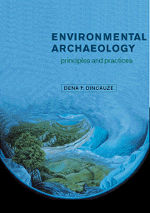Book contents
- Frontmatter
- Contents
- List of figures
- List of tables
- Preface
- Acknowledgments
- Glossary
- PART I INTRODUCTION
- 1 ENVIRONMENTAL ARCHAEOLOGY AND HUMAN ECOLOGY
- 2 CONCEPTS FOR PALEOENVIRONMENTAL RECONSTRUCTION
- 3 MECHANISMS OF ENVIRONMENTAL CHANGE
- 4 HUMAN RESPONSES TO ENVIRONMENTAL CHANGE
- PART II CHRONOLOGY
- PART III CLIMATE
- PART IV GEOMORPHOLOGY
- PART V SEDIMENTS AND SOILS
- PART VI VEGETATION
- PART VII FAUNA
- PART VIII INTEGRATION
- References
- Index
1 - ENVIRONMENTAL ARCHAEOLOGY AND HUMAN ECOLOGY
Published online by Cambridge University Press: 20 January 2010
- Frontmatter
- Contents
- List of figures
- List of tables
- Preface
- Acknowledgments
- Glossary
- PART I INTRODUCTION
- 1 ENVIRONMENTAL ARCHAEOLOGY AND HUMAN ECOLOGY
- 2 CONCEPTS FOR PALEOENVIRONMENTAL RECONSTRUCTION
- 3 MECHANISMS OF ENVIRONMENTAL CHANGE
- 4 HUMAN RESPONSES TO ENVIRONMENTAL CHANGE
- PART II CHRONOLOGY
- PART III CLIMATE
- PART IV GEOMORPHOLOGY
- PART V SEDIMENTS AND SOILS
- PART VI VEGETATION
- PART VII FAUNA
- PART VIII INTEGRATION
- References
- Index
Summary
Ecology, a word so much in vogue in recent years that it has lost much of its original meaning, may be defined as “that branch of science concerned with [the study of] the relationships between organisms and their environment” (Hardesty 1977: 290). Environment, which is often confused with ecology, encompasses all the physical and biological elements and relationships that impinge upon a living being. Specification of an organism's environment emphasizes those variables relevant to the life of that organism – ideally, almost every aspect of its surroundings.
Advances in instrumentation for the observation and measurement of biological, planetary, and astronomical environmental phenomena have driven unprecedented recent growth in the historical geo- and biosciences. The maturing geosciences acknowledge unexpected complexity, diversity, and dynamism in the natural world, now slowly seeping into study of the social sciences as well. The biosciences have powerful new techniques for examining life at small scales, notably the molecular scale. The growth in these ancillary disciplines has opened opportunities for advances in archaeology on the basis of new data sources and richer understanding of processes and mechanisms in all historical sciences.
Archaeologists have embraced the novel results, and built on some of the new data, not always understanding the theoretical and methodological bases on which those results were founded; some of those foundations have since been shown to be unsteady. Premature adoption of poorly evaluated analytical techniques and their preliminary results has given archaeology a decade or more of spectacular claims and attendant rebuttals, creating an uneasy atmosphere.
In this atmosphere and by such means, environmental archaeology has gained a reputation as being driven by method at the expense of sound practice and genuinely useful results.
- Type
- Chapter
- Information
- Environmental ArchaeologyPrinciples and Practice, pp. 3 - 19Publisher: Cambridge University PressPrint publication year: 2000

